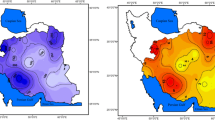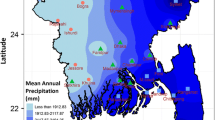Abstract
Conventional univariate drought frequency analysis should be replaced by the multivariate framework due to the correlated characteristics, such as duration, peak intensity, and severity. Compared to the bivariate case, trivariate analysis would be more considerable. Furthermore, the absence of historical records has a great impact on the reliability of statistical estimates. Multivariate regional frequency analysis approach would be a better choice for providing reliable information for risks assessment and management purpose. Standardized precipitation evapotranspiration index was used in this study to define and detect drought because of the global warming effect. A method based on the cubic spline interpolation was applied to derive drought samples. Applying the multivariate discordancy and homogeneity test, the Pearl River basin was divided into five homogeneous subregions. Regional distributions including marginal distribution and copula function were chosen based on the goodness-of-fit test. Finally, return periods were computed from a regional perspective to assess the different drought risks. The results indicate that high drought risks might exist in the Pearl River basin and the spatial distinction must be taken seriously. Due to the contradiction of water supply and requirement among different districts or provinces, policies needed to be made seriously and urgently to solve the unbalance between water resource and socioeconomic development.











Similar content being viewed by others
References
Wilhite, D.A., Glantz, M.H.: Understanding the drought phenomenon: the role of definitions. Water Int. 10, 111–120 (1985)
Sönmez, F.K., Ümran-Kömüscü, A., Erkan, A., Turgu, E.: An analysis of spatial and temporal dimension of drought vulnerability in Turkey using the standardized precipitation index. Nat. Hazards 35, 243–264 (2005). doi:10.1007/s11069-004-5704-7
McKee, T.B., Doeskin, N.J., Klerst, J.: The relationship of drought frequency and duration to time scales. In: Proceedings of the 8th Conference on Applied Climatology, January 17–22, Anaheim, California, pp. 179–184 (1993)
Lloyd-Hughes, B., Saunders, M.A.: A drought climatology for Europe. Int. J. Climatol. 22, 1571–1592 (2002). doi:10.1002/joc.846
Mishra, A.K., Singh, V.P.: A review of drought concepts. J. Hydrol. 391, 202–216 (2010)
Kampragou, E., Apostolaki, S., Manoli, E., Froebrich, J., Assimacopoulos, D.: Towards the harmonization of water-related policies for managing drought risks across the EU. Environ. Sci. Policy 14(7), 815–824 (2011)
Zou, X., Zhai, P., Zhang, Q.: Variations in drought over China: 1951–2003. Geophys. Res. Lett. 32, L04707 (2005). doi:10.1029/2004GL021853
Le Comete, D.: Weather highlights around the world. Weatherwise 47, 23–26 (1994)
Le Comete, D.: Weather highlights around the world. Weatherwise 48, 20–22 (1995)
Ross, T., Lott, N.: A Climatic of 1980–2003 Extreme Weather and Climate Events. National Climatic Data Center, Asheville, NC. http://www.ncdc.noaa.gov/ol/reports/billionz.html (2003)
Bond, N.R., Lake, P.S., Arthington, A.H.: The impacts of drought on freshwater ecosystems: an Australian perspective. Hydrobiologia 600(1), 3–16 (2008)
Shiau, J.T.: Fitting drought duration and severity with two-dimensional copulas. Water Resour. Manag. 20(5), 795–815 (2006)
Yue, S.: Applying bivariate normal distribution to flood frequency analysis. Water Int. 24(3), 248–254 (1999)
Favre, A.-C., Musy, A., Morgenthaler, S.: Two-site modeling of rainfall based on the Neyman–Scott process. Water Resour. Res. 38(12), 1307 (2002). doi:10.1029/2002WR001343
Yue, S., Ouarda, T.B.M.J., Bobée, B.: A review of bivariate gamma distribution for hydrological application. J. Hydrol. 246, 1–18 (2001)
Adamson, P.T., Metcalfe, A.V., Parmentier, B.: Bivariate extreme value distributions: an application of the Gibbs sampler to the analysis of floods. Water Resour. Res. 35, 2825–2832 (1999)
Favre, A.-C., Adlouni, S.E., Perreault, L., Thiémonge, N., Bobée, B.: Multivariate hydrological frequency analysis using copulas. Water Resour. Res. 40, W01101 (2004). doi:10.1029/2003WR002456
Yevjevich, V.M.: An objective approach to definitions and investigations of continential hydrologic drought. Hydrology Paper 23, Colorado (1967)
Shiau, J.T., Feng, S., Nadarajah, S.: Assessment of hydrological droughts for the Yellow River, China, using copulas. Hydrol. Process. 21(16), 2157–2163 (2007)
Mirabbasi, R., Fakheri-Fard, A., Dinpashoh, Y.: Bivariate drought frequency analysis using the copula method. Theor. Appl. Climatol. (2011). doi:10.1007/s00704-011-0524-7
Ganguli, P., Reddy, M.J.: Risk assessment of droughts in Gujarat using bivariate copulas. Water Resour. Manag. 26, 3301–3327 (2012)
González, J., Valdés, J.: Bivariate drought recurrence analysis using tree ring reconstructions. J. Hydrol. Eng. 8(5), 247–258 (2003)
Serinaldi, F., Grimaldi, S.: Fully nested 3-copula: procedure and application on hydrological data. J. Hydrol. Eng. 12(4), 420–430 (2007)
Ganguli, P., Reddy, M.J.: Probabilistic assessment of flood risks using trivariate copulas. Theor. Appl. Climatol. 111, 341–360 (2013)
Zhang, L., Singh, V.P.: Gumbel–Hougaard copula for trivariate rainfall frequency analysis. J. Hydrol. Eng. 12(4), 409–419 (2007)
Kao, S.-C., Govindaraju, R.S.: Trivariate statistical analysis of extreme rainfall events via the Plackett family of copulas. Water Resour. Res. 44, W02415 (2008). doi:10.1029/2007WR006261
Wong, G., Lambert, M.F., Leonard, M., Metcalfe, A.V.: Drought analysis using trivariate copulas conditional on climatic states. J. Hydrol. Eng. 15(2), 129–141 (2010)
Song, S.B., Singh, V.P.: Frequency analysis of drought using the Plackett copula and parameter estimation by genetic algorithm. Stoch. Environ. Res. Risk Assess. 24, 783–805 (2010)
Ma, M.W., Song, S.B., Ren, L.L., Jiang, S.H., Song, J.L.: Multivariate drought characteristics using trivariate Gaussian and Student t copula. Hydrol. Process. 27(8), 1175–1190 (2012)
Kite, G.W.: Frequency and Risk Analysis in Hydrology. Water Resources Publications, Littleton (1988)
Hosking, J.R.M., Wallis, J.R.: Some statistics useful in regional frequency analysis. Water Resour. Res. 29, 271–281 (1993)
Hosking, J.R.M., Wallis, J.R.: Regional Frequency Analysis: An Approach Based on L-Moments. Cambridge University Press, Cambridge (1997)
Mirakbari, M., Ganji, A., Fallah, S.R.: Regional bivariate frequency analysis of meteorological droughts. J. Hydrol. Eng. 15(12), 985–1000 (2010)
Yoo, J.Y., Kwon, H.-H., Kim, T.-W., Ahn, J.-H.: Drought frequency analysis using cluster analysis and bivariate probability distribution. J. Hydrol. 420–421, 102–111 (2012)
Chebana, F., Ouarda, T.B.M.J.: Multivariate L-moment homogeneity test. Water Resour. Res. 43, W08406 (2007). doi:10.1029/2006WR005639
Chebana, F., Ouarda, T.B.M.J.: Index flood-based multivariate regional frequency analysis. Water Resour. Res. 45, W10435 (2009). doi:10.1029/2008WR007490
Zhang, Q., Singh, V.P., Peng, J.T., Chen, Y.Q., Li, J.F.: Spatial-temporal changes of precipitation structure across the Pearl River basin, China. J. Hydrol. 440–441(10), 113–122 (2012)
Yan, Q.: Drought, highlights the contradiction between supply and demand of water resources in the Pearl River basin. Pearl River Water Resources Commission, Ministry of Water Resources of China. http://www.zwsw.gov.cn/zjls/13680.shtml (2009)
Gemmer, M., Fischer, T., Su, B., Liu, L.L.: Trends of precipitation extremes in the Zhujiang River basin, south China. J. Clim. 24, 750–761 (2011)
Zargar, A., Sadiq, R., Naser, B., Khan, F.I.: A review of drought indices. Environ. Rev. 19, 333–349 (2011)
Guttman, N.B.: Comparing the Palmer drought index and the standardized precipitation index. J. Am. Water Resour. Assoc. 34(1), 113–121 (1998)
IPCC: Climate Change: The Physical Science Basis. Cambridge University Press, Cambridge (2007)
Cai, W., Cowan, T.: Evidence of impacts from rising temperature on inflows to the Murray–Darling basin. Geophys. Res. Lett. (2008). doi:10.1029/2008GL033390
Koutroulis, A.G., Tsanis, I.K., Daliakopoulos, I.N., Jacob, D.: Impact of climate change on water resources status: a case study for Crete Island, Greece. J. Hydrol. 479(13), 146–158 (2013)
Vicente-Serrano, S.M., Beguería, S., López-Moreno, J.I.: A multi-scalar drought index sensitive to global warming: the standardized precipitation evapotranspiration index SPEI. J. Clim. 23, 1696–1718 (2010)
Thornthwaite, C.W.: An approach toward a rational classification of climate. Geogr. Rev. 38(1), 55–94 (1948)
Kao, S.-C., Govindaraju, R.S.: A copula-based joint deficit index for droughts. J. Hydrol. 380(1), 121–134 (2010)
Svoboda, M., LeComte, D., Hayes, M., Heim, R., Gloeason, K., Angel, J., Rippey, B., Tinker, R., Palecki, M., Stooksbury, D., Stephens, S.: The drought monitor. Bull. Am. Meteorol. Soc. 83(8), 1181–1190 (2002)
Angrew, C.T.: Using SPI to identify drought. Drought Netw. News 12, 6–12 (2000)
Santos, J.F., Pulido-Calvo, I., Portela, M.M.: Spatial and temporal variability of droughts in Portugal. Water Resour. Res. 46, W03503 (2010). doi:10.1029/2009WR008071
Nelson, R.B.: An Introduction to Copulas, 2nd edn. Springer, New York (2006)
Sklar, A.: Fonctionsdé repartition àn dimensions et leurs margins. Publ. Inst. Statist. Univ. Paris 8, 229–231 (1959)
Grimaldi, S., Serinaldi, F.: Asymmetric copula in multivariate flood frequency analysis. Adv. Water Resour. 29(8), 1155–1167 (2006)
Genest, C., Rivest, L.-P.: On the multivariate probability integral transformation. Stat. Probab. Lett. 53(4), 391–399 (2001)
Salvadori, G., De Michele, C., Durante, F.: On the return period and design in a multivariate framework. Hydrol. Earth Syst. Sci. 15, 3293–3305 (2011)
Salvadori, G., De Michele, C.: Frequency analysis via copulas: theoretical aspects and applications to hydrological events. Water Resour. Res. 40, W12511 (2004). doi:10.1029/2004WR003133
Hosking, J.R.M.: L-Moments: analysis and estimation of distributions using linear combinations of order statistics. J. R. Stat. Soc. B 52(1), 105–124 (1990)
Serfling, R., Xiao, P.: A contribution to multivariate L-moments: L-moment matrices. J. Multivar. Anal. 98(9), 1765–1781 (2007)
Horn, R.A., Johnson, C.R.: Matrix Analysis. Cambridge University Press, Cambridge (1990)
Akaike, H.: A new look at the statistical model identification. IEEE Trans. Autom. Control 19(6), 716–723 (1974)
Salvadori, G., De Michele, C.: Multivariate multiparameter extreme value models and return period: a copula approach. Water Resour. Res. 46, W10501 (2010). doi:10.1029/2009WR009040
Dalrymple, T.: Flood frequency method. U.S. Geological Survey, Water Supply Paper, 1543A, pp. 11–51 (1960)
Hannachi, A., Jolliffe, I.T., Stephenson, D.B.: Empirical orthogonal functions and related techniques in atmospheric science: a review. Int. J. Climatol. 27, 1119–1152 (2007)
Acknowledgements
The data used in this study was supported by China Meteorological Administration. We thank the people who have given advice on our study, and also express our gratitude to those who make careful improvements to this paper.
Author information
Authors and Affiliations
Corresponding author
Rights and permissions
About this article
Cite this article
Huang, Q., Li, J. & Gao, J. The risks assessment via a regional approach using multivariate regional frequency clustering method. Cluster Comput 20, 3441–3457 (2017). https://doi.org/10.1007/s10586-017-1126-7
Received:
Revised:
Accepted:
Published:
Issue Date:
DOI: https://doi.org/10.1007/s10586-017-1126-7




